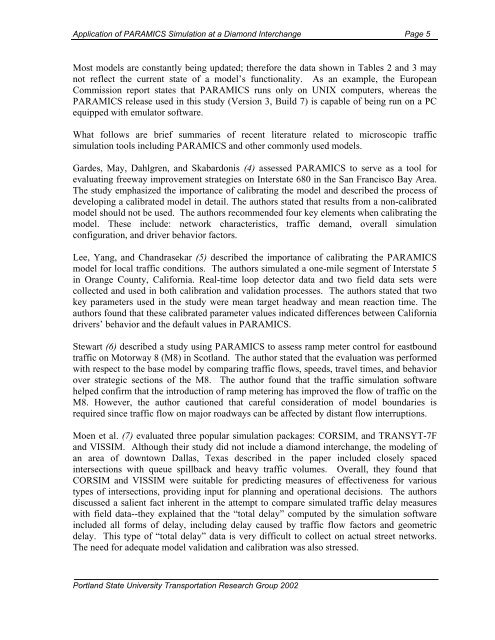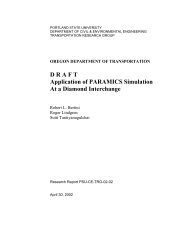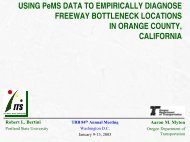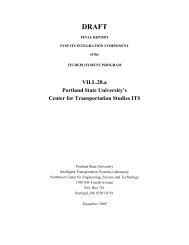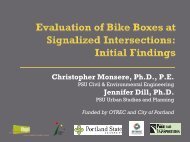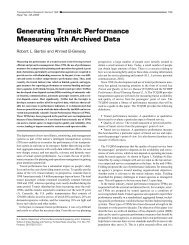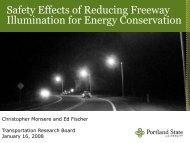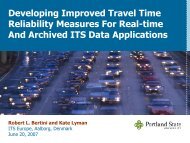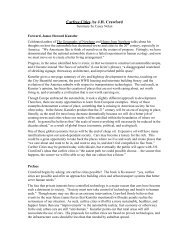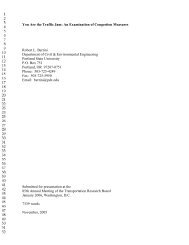Application of Paramics Simulation to a Diamond Interchange
Application of Paramics Simulation to a Diamond Interchange
Application of Paramics Simulation to a Diamond Interchange
You also want an ePaper? Increase the reach of your titles
YUMPU automatically turns print PDFs into web optimized ePapers that Google loves.
<strong>Application</strong> <strong>of</strong> PARAMICS <strong>Simulation</strong> at a <strong>Diamond</strong> <strong>Interchange</strong> Page 5<br />
Most models are constantly being updated; therefore the data shown in Tables 2 and 3 may<br />
not reflect the current state <strong>of</strong> a model’s functionality. As an example, the European<br />
Commission report states that PARAMICS runs only on UNIX computers, whereas the<br />
PARAMICS release used in this study (Version 3, Build 7) is capable <strong>of</strong> being run on a PC<br />
equipped with emula<strong>to</strong>r s<strong>of</strong>tware.<br />
What follows are brief summaries <strong>of</strong> recent literature related <strong>to</strong> microscopic traffic<br />
simulation <strong>to</strong>ols including PARAMICS and other commonly used models.<br />
Gardes, May, Dahlgren, and Skabardonis (4) assessed PARAMICS <strong>to</strong> serve as a <strong>to</strong>ol for<br />
evaluating freeway improvement strategies on Interstate 680 in the San Francisco Bay Area.<br />
The study emphasized the importance <strong>of</strong> calibrating the model and described the process <strong>of</strong><br />
developing a calibrated model in detail. The authors stated that results from a non-calibrated<br />
model should not be used. The authors recommended four key elements when calibrating the<br />
model. These include: network characteristics, traffic demand, overall simulation<br />
configuration, and driver behavior fac<strong>to</strong>rs.<br />
Lee, Yang, and Chandrasekar (5) described the importance <strong>of</strong> calibrating the PARAMICS<br />
model for local traffic conditions. The authors simulated a one-mile segment <strong>of</strong> Interstate 5<br />
in Orange County, California. Real-time loop detec<strong>to</strong>r data and two field data sets were<br />
collected and used in both calibration and validation processes. The authors stated that two<br />
key parameters used in the study were mean target headway and mean reaction time. The<br />
authors found that these calibrated parameter values indicated differences between California<br />
drivers’ behavior and the default values in PARAMICS.<br />
Stewart (6) described a study using PARAMICS <strong>to</strong> assess ramp meter control for eastbound<br />
traffic on Mo<strong>to</strong>rway 8 (M8) in Scotland. The author stated that the evaluation was performed<br />
with respect <strong>to</strong> the base model by comparing traffic flows, speeds, travel times, and behavior<br />
over strategic sections <strong>of</strong> the M8. The author found that the traffic simulation s<strong>of</strong>tware<br />
helped confirm that the introduction <strong>of</strong> ramp metering has improved the flow <strong>of</strong> traffic on the<br />
M8. However, the author cautioned that careful consideration <strong>of</strong> model boundaries is<br />
required since traffic flow on major roadways can be affected by distant flow interruptions.<br />
Moen et al. (7) evaluated three popular simulation packages: CORSIM, and TRANSYT-7F<br />
and VISSIM. Although their study did not include a diamond interchange, the modeling <strong>of</strong><br />
an area <strong>of</strong> down<strong>to</strong>wn Dallas, Texas described in the paper included closely spaced<br />
intersections with queue spillback and heavy traffic volumes. Overall, they found that<br />
CORSIM and VISSIM were suitable for predicting measures <strong>of</strong> effectiveness for various<br />
types <strong>of</strong> intersections, providing input for planning and operational decisions. The authors<br />
discussed a salient fact inherent in the attempt <strong>to</strong> compare simulated traffic delay measures<br />
with field data--they explained that the “<strong>to</strong>tal delay” computed by the simulation s<strong>of</strong>tware<br />
included all forms <strong>of</strong> delay, including delay caused by traffic flow fac<strong>to</strong>rs and geometric<br />
delay. This type <strong>of</strong> “<strong>to</strong>tal delay” data is very difficult <strong>to</strong> collect on actual street networks.<br />
The need for adequate model validation and calibration was also stressed.<br />
Portland State University Transportation Research Group 2002


